Attractions · Europe · Going Out · Portugal · Regions · Restaurants · Western Europe
UNESCO World Heritage Sites you won’t want to miss on your visit to central Portugal
The Algarve, Portugal is a well known holiday destination famous for its sun drenched beaches, stunning scenery, fantastic golf courses and surfing. But for the more discerning traveller, Portugal is so much more. It is a land of diversity, steeped in heritage and culture, with castles and monuments that are well preserved and a variety of UNESCO World Heritage Sites, amazing vineyards and cities where you can lose yourself in a bygone era, without compromising on modern day luxuries.
 Central Portugal may not be the top of the list for a holiday of luxury, heritage and culture, as the region is still relatively unknown to the world as a top travel destination, and sometimes we wonder if it would be better to remain so. But there are 3 locations in Central Portugal that should top the list of any visit, each very different, but with the the honour of being UNESCO World Heritage Sites.
These are Coimbra, Alcobaça and Tomar. Each location is within easy reach of Lisbon and Porto so can be taken as a day trip on your city break, or you can use the option of staying on the beautiful Silver Coast as a base for exploring all this region has to offer combined with a beach holiday. You will not be disappointed with the cuisine and dining, the numerous vineyards and dramatic landscapes of this area, which also has far less tourists and holiday makers than other areas of Portugal.
Alcobaça
Alcobaça is a town with a tragic, romantic history. Located on the Silver Coast approx. 100 kilometres from Lisbon airport and approx. 200 kms from Porto airport. The story starts when king Afonso Henriques ordered the construction of a church to commemorate the conquest of Santarém from the Moors in 1147. The original building continued to evolve into one of the most significant gothic monuments in Portugal, it was 60 years later King Dinis built the main cloister and the Monastery was consecrated in 1262 and listed as a World heritage site in 1989.
Central Portugal may not be the top of the list for a holiday of luxury, heritage and culture, as the region is still relatively unknown to the world as a top travel destination, and sometimes we wonder if it would be better to remain so. But there are 3 locations in Central Portugal that should top the list of any visit, each very different, but with the the honour of being UNESCO World Heritage Sites.
These are Coimbra, Alcobaça and Tomar. Each location is within easy reach of Lisbon and Porto so can be taken as a day trip on your city break, or you can use the option of staying on the beautiful Silver Coast as a base for exploring all this region has to offer combined with a beach holiday. You will not be disappointed with the cuisine and dining, the numerous vineyards and dramatic landscapes of this area, which also has far less tourists and holiday makers than other areas of Portugal.
Alcobaça
Alcobaça is a town with a tragic, romantic history. Located on the Silver Coast approx. 100 kilometres from Lisbon airport and approx. 200 kms from Porto airport. The story starts when king Afonso Henriques ordered the construction of a church to commemorate the conquest of Santarém from the Moors in 1147. The original building continued to evolve into one of the most significant gothic monuments in Portugal, it was 60 years later King Dinis built the main cloister and the Monastery was consecrated in 1262 and listed as a World heritage site in 1989.
 Although a magnificent structure there is a dark side to the monastery, and this is where the romantic tragedy is revealed, to prevent further wars, Pedro (the son of King Afonso IV) was married to Constanza, a princess of Castille, though in love with Inés de Castro. Constanza died shortly after the marriage and Dom Pedro escaped with Inés.
Believing Inés was a threat, King Afonso IV had her murdered. Following the death of Afonso, Pedro declared he had married Inés and had her body exhumed and her embalmed corpse seated on the throne wearing a crown. All courtiers were then instructed to pay homage to his true love and queen. Legend states that Pedro went on to find the murderers and ripped out their hearts with his own hands as punishment. Their ornate tombs can be found in the Monastery, next to each other, so they will always be together. The love story and father/son conflict has inspired more than 20 operas.
Although a magnificent structure there is a dark side to the monastery, and this is where the romantic tragedy is revealed, to prevent further wars, Pedro (the son of King Afonso IV) was married to Constanza, a princess of Castille, though in love with Inés de Castro. Constanza died shortly after the marriage and Dom Pedro escaped with Inés.
Believing Inés was a threat, King Afonso IV had her murdered. Following the death of Afonso, Pedro declared he had married Inés and had her body exhumed and her embalmed corpse seated on the throne wearing a crown. All courtiers were then instructed to pay homage to his true love and queen. Legend states that Pedro went on to find the murderers and ripped out their hearts with his own hands as punishment. Their ornate tombs can be found in the Monastery, next to each other, so they will always be together. The love story and father/son conflict has inspired more than 20 operas.
 Other aspects of the Monastery to be admired are the “Cloister of Silence" and the impressive kitchen, which incorporated a diverted stream to provide a constant supply of spring water. The monastery takes pride of place in the town centre and the open space at the front is now lined with a parade of small shops, cafes and restaurants where you can sit and admire the architecture.
Other aspects of the Monastery to be admired are the “Cloister of Silence" and the impressive kitchen, which incorporated a diverted stream to provide a constant supply of spring water. The monastery takes pride of place in the town centre and the open space at the front is now lined with a parade of small shops, cafes and restaurants where you can sit and admire the architecture.
 Although the monastery is the main attraction of Alcobaça there are other attractions to visit such as: the Museu do Vinho de Alcobaça, built by José Eduardo Raposo de Magalhães, who took over the winery in the 1870’s and equipped it with (then) state of the art technology; Castelo de Alcobaça, the castle ruins overlook the town; and Mosteiro de Santa Maria de Cós built in the 12th century for widows and rebuilt in the 1600s, it became a centre for the Cistercian nuns.
If you choose to stay in Alcobaça there are a selection of spa hotels close by or a selection of private villas to choose from. Alcobaça has a good range of restaurants serving traditional Portuguese foods or for lunch, you could try António Padeiro (beware this restaurant is only open at lunchtime) which has the following review from the Michelin guide: “A third-generation business teeming with history that first opened as a bakery, then a brewery, before its final conversion into a restaurant specialising in home-style cooking”.
Tomar
Tomar is located in the Santarem district of Portugal and is approx. 130 kilometres from Lisbon airport and 200 kilometres from Porto, with a fantastic array of restaurants, architecture and parks.
The most notable monument in Tomar is the Convento de Cristo (The Convent of Christ) which is one of the chief works of the Portuguese Renaissance. The convent and castle were originally a Roman Catholic convent built in the 12th century and a Templar stronghold, in the 14th century the order of the Templar Knights were dissolved and became the knights of the order of Christ and the Convento de Cristo was listed as a UNESCO world heritage site in 1983.
One of the oldest parts of the building is the Charola (Rotunda) and when the convent and castle were first built, they were Portugal’s most up-to-date and advanced military set-up. In the 16th century, king Manuel I ordered restoration works, which was when the architectural masterpiece became what it is today. As tempting as it may seem, walking to the Convento de Cristo is not recommended, the road is very narrow and steep. Though this monument is the main attraction in Tomar, it is certainly not the only reason to visit.
Although the monastery is the main attraction of Alcobaça there are other attractions to visit such as: the Museu do Vinho de Alcobaça, built by José Eduardo Raposo de Magalhães, who took over the winery in the 1870’s and equipped it with (then) state of the art technology; Castelo de Alcobaça, the castle ruins overlook the town; and Mosteiro de Santa Maria de Cós built in the 12th century for widows and rebuilt in the 1600s, it became a centre for the Cistercian nuns.
If you choose to stay in Alcobaça there are a selection of spa hotels close by or a selection of private villas to choose from. Alcobaça has a good range of restaurants serving traditional Portuguese foods or for lunch, you could try António Padeiro (beware this restaurant is only open at lunchtime) which has the following review from the Michelin guide: “A third-generation business teeming with history that first opened as a bakery, then a brewery, before its final conversion into a restaurant specialising in home-style cooking”.
Tomar
Tomar is located in the Santarem district of Portugal and is approx. 130 kilometres from Lisbon airport and 200 kilometres from Porto, with a fantastic array of restaurants, architecture and parks.
The most notable monument in Tomar is the Convento de Cristo (The Convent of Christ) which is one of the chief works of the Portuguese Renaissance. The convent and castle were originally a Roman Catholic convent built in the 12th century and a Templar stronghold, in the 14th century the order of the Templar Knights were dissolved and became the knights of the order of Christ and the Convento de Cristo was listed as a UNESCO world heritage site in 1983.
One of the oldest parts of the building is the Charola (Rotunda) and when the convent and castle were first built, they were Portugal’s most up-to-date and advanced military set-up. In the 16th century, king Manuel I ordered restoration works, which was when the architectural masterpiece became what it is today. As tempting as it may seem, walking to the Convento de Cristo is not recommended, the road is very narrow and steep. Though this monument is the main attraction in Tomar, it is certainly not the only reason to visit.
 The main historical centre (Praça da República) has a cross-shaped layout, orientated along the points of the compass, with a convent at each end. The town square has a selection of cafes and restaurants in which to enjoy to the views.
The Church of Saint John the Baptist (Igreja de São João Baptista) a 15th century catholic church sits at one end of the town square and on the opposite side is the municipality, which is 17th century. Behind this on the top of the Hill is the Convento de Cristo.
The main historical centre (Praça da República) has a cross-shaped layout, orientated along the points of the compass, with a convent at each end. The town square has a selection of cafes and restaurants in which to enjoy to the views.
The Church of Saint John the Baptist (Igreja de São João Baptista) a 15th century catholic church sits at one end of the town square and on the opposite side is the municipality, which is 17th century. Behind this on the top of the Hill is the Convento de Cristo.
 The River Nabão flows through the town with Mouchão Park running along one side, here you will see, the still working wooden Mouchão water wheel, as well preserved as all the other sites in Tomar.
Just a few kilometres outside of the town centre you will find the Aqueduto dos Pegões Altos. This aqueduct was built in the 16th century and was used to bring water to the Convento de Cristo and stretches for approx. 6 kms, the highest part reaching almost 30 metres in height.
The River Nabão flows through the town with Mouchão Park running along one side, here you will see, the still working wooden Mouchão water wheel, as well preserved as all the other sites in Tomar.
Just a few kilometres outside of the town centre you will find the Aqueduto dos Pegões Altos. This aqueduct was built in the 16th century and was used to bring water to the Convento de Cristo and stretches for approx. 6 kms, the highest part reaching almost 30 metres in height.
 If you choose to stay in Tomar there are 2 four star hotels the Hotel Dos Templarios or the Thomar Boutique Hotel or if you are looking for a little more privacy, there are a variety of luxury villas with private pools available. Though there are no Michelin-reviewed restaurants, there are many places to eat serving a selection of traditional Portuguese cuisine or international foods.
Coimbra
Coimbra, once the capital city of Portugal is set overlooking the river Mondego, you can see the magnificent buildings as you approach due to the city’s elevated position. The city is approximately 200 kilometres from Lisbon airport and approximately 135 kilometres from Porto airport, again making this city an easy day trip or the perfect base for a holiday. As the city declined from the political centre of the country it grew into a cultural hub. Steeped in history, with many of the prestigious buildings from its time as the capital still intact, there is a vibrant atmosphere in the city.
The main feature of Coimbra is the university. This is the oldest in Portugal and one of the oldest in the world, founded in the 13 th century and still in use today. Tours are available where you can visit the the Chapel of São Miguel which houses an imposing Baroque organ and the Joanine Library, where you will find thousands of books dating back to the 16th century, arranged in beautiful gilt-covered bookcases. The Joanine library is easily one of the best examples of the Baroque style. The sheer opulence of the building leaves you breathless. As you tour the buildings you will see some of the best architecture available in Portugal and if you climb the tower you will have access to a 360-degree view of Coimbra. The university was awarded UNESCO World Heritage Site status in 2013; this also expands to cover Rua da Sofia and the upper part of the city.
If you choose to stay in Tomar there are 2 four star hotels the Hotel Dos Templarios or the Thomar Boutique Hotel or if you are looking for a little more privacy, there are a variety of luxury villas with private pools available. Though there are no Michelin-reviewed restaurants, there are many places to eat serving a selection of traditional Portuguese cuisine or international foods.
Coimbra
Coimbra, once the capital city of Portugal is set overlooking the river Mondego, you can see the magnificent buildings as you approach due to the city’s elevated position. The city is approximately 200 kilometres from Lisbon airport and approximately 135 kilometres from Porto airport, again making this city an easy day trip or the perfect base for a holiday. As the city declined from the political centre of the country it grew into a cultural hub. Steeped in history, with many of the prestigious buildings from its time as the capital still intact, there is a vibrant atmosphere in the city.
The main feature of Coimbra is the university. This is the oldest in Portugal and one of the oldest in the world, founded in the 13 th century and still in use today. Tours are available where you can visit the the Chapel of São Miguel which houses an imposing Baroque organ and the Joanine Library, where you will find thousands of books dating back to the 16th century, arranged in beautiful gilt-covered bookcases. The Joanine library is easily one of the best examples of the Baroque style. The sheer opulence of the building leaves you breathless. As you tour the buildings you will see some of the best architecture available in Portugal and if you climb the tower you will have access to a 360-degree view of Coimbra. The university was awarded UNESCO World Heritage Site status in 2013; this also expands to cover Rua da Sofia and the upper part of the city.

 Coimbra offers much more than the university with meandering cobbled streets, fantastic architecture and proud parks and gardens. In the main shopping and historic area, you will find the Monastery of Santa Cruz, which houses the tomb of the first King of Portugal, Afonso Henriques.
If you choose to stay in Coimbra there are a selection of 5-star luxury spa and boutique hotels with high class restaurants and roof top bars or a selection of private villas to choose from. If you choose to stay at Quinta das Lágrimas, the palace has been converted into a luxury hotel with a Michelin starred restaurant.
Jenny Lovett is the Founder of Portugalholidays4u.com. Portugalholidays4u.com is a website showcasing all that Portugal has to offer with an extensive collection of villas, apartments and holiday accommodation.
If you would like to be a guest blogger on A Luxury Travel Blog in order to raise your profile, please contact us.
Coimbra offers much more than the university with meandering cobbled streets, fantastic architecture and proud parks and gardens. In the main shopping and historic area, you will find the Monastery of Santa Cruz, which houses the tomb of the first King of Portugal, Afonso Henriques.
If you choose to stay in Coimbra there are a selection of 5-star luxury spa and boutique hotels with high class restaurants and roof top bars or a selection of private villas to choose from. If you choose to stay at Quinta das Lágrimas, the palace has been converted into a luxury hotel with a Michelin starred restaurant.
Jenny Lovett is the Founder of Portugalholidays4u.com. Portugalholidays4u.com is a website showcasing all that Portugal has to offer with an extensive collection of villas, apartments and holiday accommodation.
If you would like to be a guest blogger on A Luxury Travel Blog in order to raise your profile, please contact us.
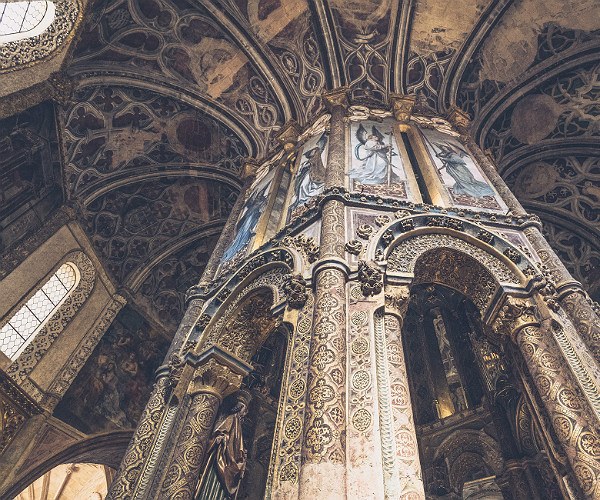 Central Portugal may not be the top of the list for a holiday of luxury, heritage and culture, as the region is still relatively unknown to the world as a top travel destination, and sometimes we wonder if it would be better to remain so. But there are 3 locations in Central Portugal that should top the list of any visit, each very different, but with the the honour of being UNESCO World Heritage Sites.
These are Coimbra, Alcobaça and Tomar. Each location is within easy reach of Lisbon and Porto so can be taken as a day trip on your city break, or you can use the option of staying on the beautiful Silver Coast as a base for exploring all this region has to offer combined with a beach holiday. You will not be disappointed with the cuisine and dining, the numerous vineyards and dramatic landscapes of this area, which also has far less tourists and holiday makers than other areas of Portugal.
Alcobaça
Alcobaça is a town with a tragic, romantic history. Located on the Silver Coast approx. 100 kilometres from Lisbon airport and approx. 200 kms from Porto airport. The story starts when king Afonso Henriques ordered the construction of a church to commemorate the conquest of Santarém from the Moors in 1147. The original building continued to evolve into one of the most significant gothic monuments in Portugal, it was 60 years later King Dinis built the main cloister and the Monastery was consecrated in 1262 and listed as a World heritage site in 1989.
Central Portugal may not be the top of the list for a holiday of luxury, heritage and culture, as the region is still relatively unknown to the world as a top travel destination, and sometimes we wonder if it would be better to remain so. But there are 3 locations in Central Portugal that should top the list of any visit, each very different, but with the the honour of being UNESCO World Heritage Sites.
These are Coimbra, Alcobaça and Tomar. Each location is within easy reach of Lisbon and Porto so can be taken as a day trip on your city break, or you can use the option of staying on the beautiful Silver Coast as a base for exploring all this region has to offer combined with a beach holiday. You will not be disappointed with the cuisine and dining, the numerous vineyards and dramatic landscapes of this area, which also has far less tourists and holiday makers than other areas of Portugal.
Alcobaça
Alcobaça is a town with a tragic, romantic history. Located on the Silver Coast approx. 100 kilometres from Lisbon airport and approx. 200 kms from Porto airport. The story starts when king Afonso Henriques ordered the construction of a church to commemorate the conquest of Santarém from the Moors in 1147. The original building continued to evolve into one of the most significant gothic monuments in Portugal, it was 60 years later King Dinis built the main cloister and the Monastery was consecrated in 1262 and listed as a World heritage site in 1989.
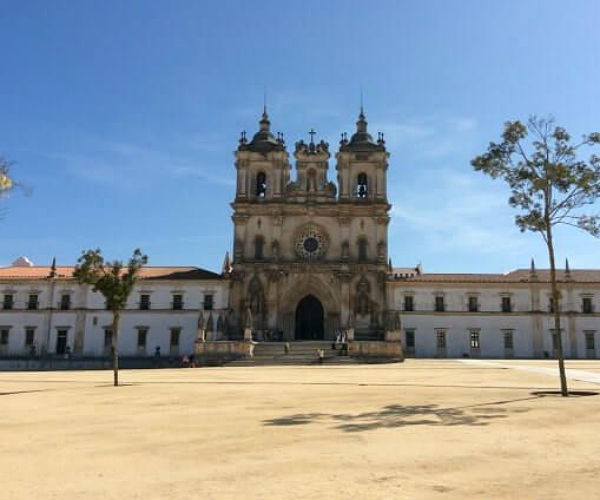 Although a magnificent structure there is a dark side to the monastery, and this is where the romantic tragedy is revealed, to prevent further wars, Pedro (the son of King Afonso IV) was married to Constanza, a princess of Castille, though in love with Inés de Castro. Constanza died shortly after the marriage and Dom Pedro escaped with Inés.
Believing Inés was a threat, King Afonso IV had her murdered. Following the death of Afonso, Pedro declared he had married Inés and had her body exhumed and her embalmed corpse seated on the throne wearing a crown. All courtiers were then instructed to pay homage to his true love and queen. Legend states that Pedro went on to find the murderers and ripped out their hearts with his own hands as punishment. Their ornate tombs can be found in the Monastery, next to each other, so they will always be together. The love story and father/son conflict has inspired more than 20 operas.
Although a magnificent structure there is a dark side to the monastery, and this is where the romantic tragedy is revealed, to prevent further wars, Pedro (the son of King Afonso IV) was married to Constanza, a princess of Castille, though in love with Inés de Castro. Constanza died shortly after the marriage and Dom Pedro escaped with Inés.
Believing Inés was a threat, King Afonso IV had her murdered. Following the death of Afonso, Pedro declared he had married Inés and had her body exhumed and her embalmed corpse seated on the throne wearing a crown. All courtiers were then instructed to pay homage to his true love and queen. Legend states that Pedro went on to find the murderers and ripped out their hearts with his own hands as punishment. Their ornate tombs can be found in the Monastery, next to each other, so they will always be together. The love story and father/son conflict has inspired more than 20 operas.
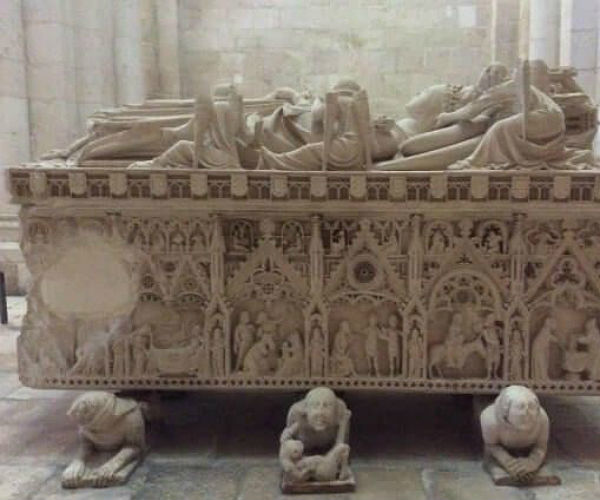 Other aspects of the Monastery to be admired are the “Cloister of Silence" and the impressive kitchen, which incorporated a diverted stream to provide a constant supply of spring water. The monastery takes pride of place in the town centre and the open space at the front is now lined with a parade of small shops, cafes and restaurants where you can sit and admire the architecture.
Other aspects of the Monastery to be admired are the “Cloister of Silence" and the impressive kitchen, which incorporated a diverted stream to provide a constant supply of spring water. The monastery takes pride of place in the town centre and the open space at the front is now lined with a parade of small shops, cafes and restaurants where you can sit and admire the architecture.
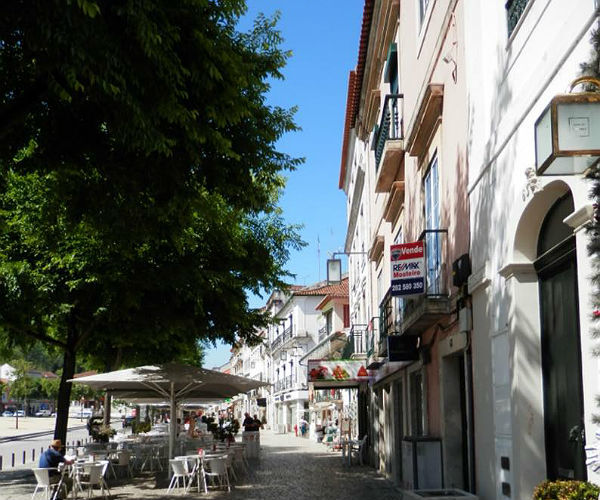 Although the monastery is the main attraction of Alcobaça there are other attractions to visit such as: the Museu do Vinho de Alcobaça, built by José Eduardo Raposo de Magalhães, who took over the winery in the 1870’s and equipped it with (then) state of the art technology; Castelo de Alcobaça, the castle ruins overlook the town; and Mosteiro de Santa Maria de Cós built in the 12th century for widows and rebuilt in the 1600s, it became a centre for the Cistercian nuns.
If you choose to stay in Alcobaça there are a selection of spa hotels close by or a selection of private villas to choose from. Alcobaça has a good range of restaurants serving traditional Portuguese foods or for lunch, you could try António Padeiro (beware this restaurant is only open at lunchtime) which has the following review from the Michelin guide: “A third-generation business teeming with history that first opened as a bakery, then a brewery, before its final conversion into a restaurant specialising in home-style cooking”.
Tomar
Tomar is located in the Santarem district of Portugal and is approx. 130 kilometres from Lisbon airport and 200 kilometres from Porto, with a fantastic array of restaurants, architecture and parks.
The most notable monument in Tomar is the Convento de Cristo (The Convent of Christ) which is one of the chief works of the Portuguese Renaissance. The convent and castle were originally a Roman Catholic convent built in the 12th century and a Templar stronghold, in the 14th century the order of the Templar Knights were dissolved and became the knights of the order of Christ and the Convento de Cristo was listed as a UNESCO world heritage site in 1983.
One of the oldest parts of the building is the Charola (Rotunda) and when the convent and castle were first built, they were Portugal’s most up-to-date and advanced military set-up. In the 16th century, king Manuel I ordered restoration works, which was when the architectural masterpiece became what it is today. As tempting as it may seem, walking to the Convento de Cristo is not recommended, the road is very narrow and steep. Though this monument is the main attraction in Tomar, it is certainly not the only reason to visit.
Although the monastery is the main attraction of Alcobaça there are other attractions to visit such as: the Museu do Vinho de Alcobaça, built by José Eduardo Raposo de Magalhães, who took over the winery in the 1870’s and equipped it with (then) state of the art technology; Castelo de Alcobaça, the castle ruins overlook the town; and Mosteiro de Santa Maria de Cós built in the 12th century for widows and rebuilt in the 1600s, it became a centre for the Cistercian nuns.
If you choose to stay in Alcobaça there are a selection of spa hotels close by or a selection of private villas to choose from. Alcobaça has a good range of restaurants serving traditional Portuguese foods or for lunch, you could try António Padeiro (beware this restaurant is only open at lunchtime) which has the following review from the Michelin guide: “A third-generation business teeming with history that first opened as a bakery, then a brewery, before its final conversion into a restaurant specialising in home-style cooking”.
Tomar
Tomar is located in the Santarem district of Portugal and is approx. 130 kilometres from Lisbon airport and 200 kilometres from Porto, with a fantastic array of restaurants, architecture and parks.
The most notable monument in Tomar is the Convento de Cristo (The Convent of Christ) which is one of the chief works of the Portuguese Renaissance. The convent and castle were originally a Roman Catholic convent built in the 12th century and a Templar stronghold, in the 14th century the order of the Templar Knights were dissolved and became the knights of the order of Christ and the Convento de Cristo was listed as a UNESCO world heritage site in 1983.
One of the oldest parts of the building is the Charola (Rotunda) and when the convent and castle were first built, they were Portugal’s most up-to-date and advanced military set-up. In the 16th century, king Manuel I ordered restoration works, which was when the architectural masterpiece became what it is today. As tempting as it may seem, walking to the Convento de Cristo is not recommended, the road is very narrow and steep. Though this monument is the main attraction in Tomar, it is certainly not the only reason to visit.
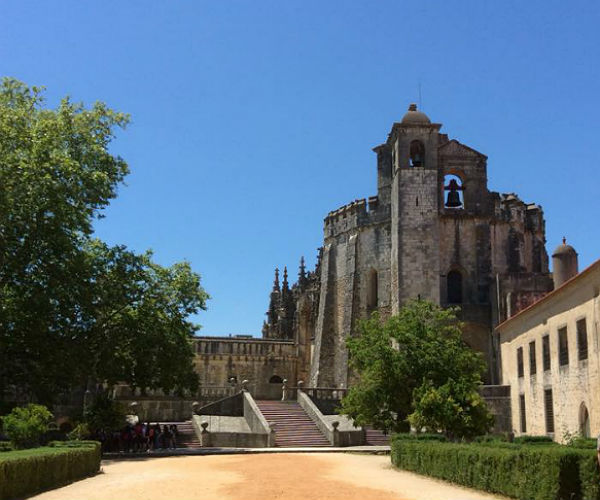 The main historical centre (Praça da República) has a cross-shaped layout, orientated along the points of the compass, with a convent at each end. The town square has a selection of cafes and restaurants in which to enjoy to the views.
The Church of Saint John the Baptist (Igreja de São João Baptista) a 15th century catholic church sits at one end of the town square and on the opposite side is the municipality, which is 17th century. Behind this on the top of the Hill is the Convento de Cristo.
The main historical centre (Praça da República) has a cross-shaped layout, orientated along the points of the compass, with a convent at each end. The town square has a selection of cafes and restaurants in which to enjoy to the views.
The Church of Saint John the Baptist (Igreja de São João Baptista) a 15th century catholic church sits at one end of the town square and on the opposite side is the municipality, which is 17th century. Behind this on the top of the Hill is the Convento de Cristo.
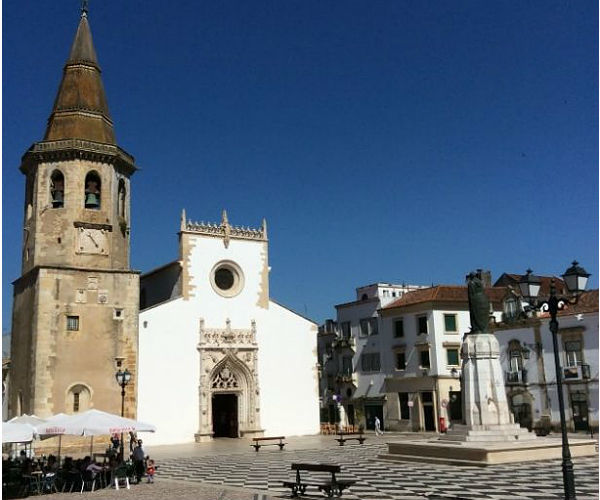 The River Nabão flows through the town with Mouchão Park running along one side, here you will see, the still working wooden Mouchão water wheel, as well preserved as all the other sites in Tomar.
Just a few kilometres outside of the town centre you will find the Aqueduto dos Pegões Altos. This aqueduct was built in the 16th century and was used to bring water to the Convento de Cristo and stretches for approx. 6 kms, the highest part reaching almost 30 metres in height.
The River Nabão flows through the town with Mouchão Park running along one side, here you will see, the still working wooden Mouchão water wheel, as well preserved as all the other sites in Tomar.
Just a few kilometres outside of the town centre you will find the Aqueduto dos Pegões Altos. This aqueduct was built in the 16th century and was used to bring water to the Convento de Cristo and stretches for approx. 6 kms, the highest part reaching almost 30 metres in height.
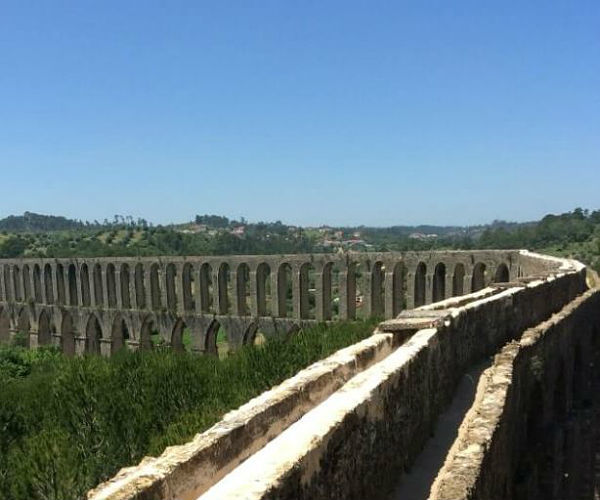 If you choose to stay in Tomar there are 2 four star hotels the Hotel Dos Templarios or the Thomar Boutique Hotel or if you are looking for a little more privacy, there are a variety of luxury villas with private pools available. Though there are no Michelin-reviewed restaurants, there are many places to eat serving a selection of traditional Portuguese cuisine or international foods.
Coimbra
Coimbra, once the capital city of Portugal is set overlooking the river Mondego, you can see the magnificent buildings as you approach due to the city’s elevated position. The city is approximately 200 kilometres from Lisbon airport and approximately 135 kilometres from Porto airport, again making this city an easy day trip or the perfect base for a holiday. As the city declined from the political centre of the country it grew into a cultural hub. Steeped in history, with many of the prestigious buildings from its time as the capital still intact, there is a vibrant atmosphere in the city.
The main feature of Coimbra is the university. This is the oldest in Portugal and one of the oldest in the world, founded in the 13 th century and still in use today. Tours are available where you can visit the the Chapel of São Miguel which houses an imposing Baroque organ and the Joanine Library, where you will find thousands of books dating back to the 16th century, arranged in beautiful gilt-covered bookcases. The Joanine library is easily one of the best examples of the Baroque style. The sheer opulence of the building leaves you breathless. As you tour the buildings you will see some of the best architecture available in Portugal and if you climb the tower you will have access to a 360-degree view of Coimbra. The university was awarded UNESCO World Heritage Site status in 2013; this also expands to cover Rua da Sofia and the upper part of the city.
If you choose to stay in Tomar there are 2 four star hotels the Hotel Dos Templarios or the Thomar Boutique Hotel or if you are looking for a little more privacy, there are a variety of luxury villas with private pools available. Though there are no Michelin-reviewed restaurants, there are many places to eat serving a selection of traditional Portuguese cuisine or international foods.
Coimbra
Coimbra, once the capital city of Portugal is set overlooking the river Mondego, you can see the magnificent buildings as you approach due to the city’s elevated position. The city is approximately 200 kilometres from Lisbon airport and approximately 135 kilometres from Porto airport, again making this city an easy day trip or the perfect base for a holiday. As the city declined from the political centre of the country it grew into a cultural hub. Steeped in history, with many of the prestigious buildings from its time as the capital still intact, there is a vibrant atmosphere in the city.
The main feature of Coimbra is the university. This is the oldest in Portugal and one of the oldest in the world, founded in the 13 th century and still in use today. Tours are available where you can visit the the Chapel of São Miguel which houses an imposing Baroque organ and the Joanine Library, where you will find thousands of books dating back to the 16th century, arranged in beautiful gilt-covered bookcases. The Joanine library is easily one of the best examples of the Baroque style. The sheer opulence of the building leaves you breathless. As you tour the buildings you will see some of the best architecture available in Portugal and if you climb the tower you will have access to a 360-degree view of Coimbra. The university was awarded UNESCO World Heritage Site status in 2013; this also expands to cover Rua da Sofia and the upper part of the city.
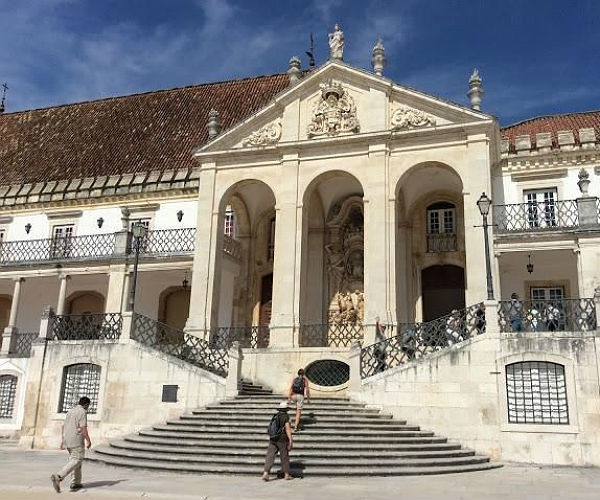
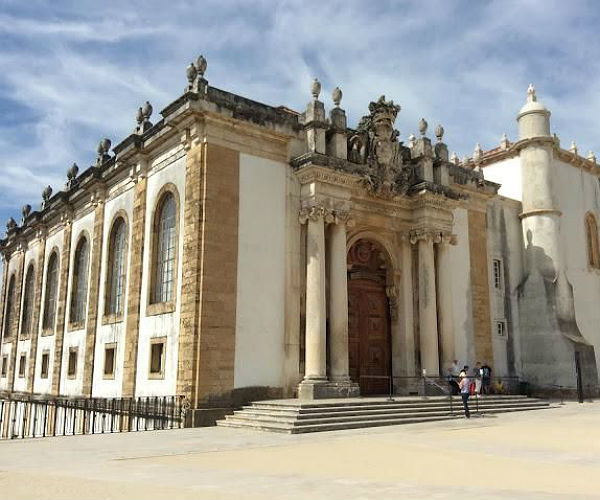 Coimbra offers much more than the university with meandering cobbled streets, fantastic architecture and proud parks and gardens. In the main shopping and historic area, you will find the Monastery of Santa Cruz, which houses the tomb of the first King of Portugal, Afonso Henriques.
If you choose to stay in Coimbra there are a selection of 5-star luxury spa and boutique hotels with high class restaurants and roof top bars or a selection of private villas to choose from. If you choose to stay at Quinta das Lágrimas, the palace has been converted into a luxury hotel with a Michelin starred restaurant.
Jenny Lovett is the Founder of Portugalholidays4u.com. Portugalholidays4u.com is a website showcasing all that Portugal has to offer with an extensive collection of villas, apartments and holiday accommodation.
If you would like to be a guest blogger on A Luxury Travel Blog in order to raise your profile, please contact us.
Coimbra offers much more than the university with meandering cobbled streets, fantastic architecture and proud parks and gardens. In the main shopping and historic area, you will find the Monastery of Santa Cruz, which houses the tomb of the first King of Portugal, Afonso Henriques.
If you choose to stay in Coimbra there are a selection of 5-star luxury spa and boutique hotels with high class restaurants and roof top bars or a selection of private villas to choose from. If you choose to stay at Quinta das Lágrimas, the palace has been converted into a luxury hotel with a Michelin starred restaurant.
Jenny Lovett is the Founder of Portugalholidays4u.com. Portugalholidays4u.com is a website showcasing all that Portugal has to offer with an extensive collection of villas, apartments and holiday accommodation.
If you would like to be a guest blogger on A Luxury Travel Blog in order to raise your profile, please contact us.Did you enjoy this article?
Receive similar content direct to your inbox.


Yes, central Portugal is a forgotten gem. A long time ago I visited Coimbra and it was very quiet apart from a couple of buses calling in briefly on a whistle stop tour of Europe. There was a real beauty to the architecture.
Coimbra was the beginning of our love affair with Portugal. It was the first city we visited and every time we go back we enjoy it more and more. Though it is getting busier, it is still far more laid back than Lisbon and Porto
With all the focus on Spain taking wealth from the New World we often forget that the Portuguese were very busy in the great Age of Navigation. They set up a lot of new trade routes and used that wealth to build some of the rich buildings shown in the pictures.
Portugal does not seem to get the same press as many other countries, and during that period there is even discussion as to whether the Portuguese were the first to give name to the famous mixture of spices that make ‘curry’
King Afonso IV really was taking no chances, having Inés murdered. But for Pedro to have her body dug up to put the corpse on a throne, wearing a crown..? That is pretty disturbing, if true! Still, it’s quite touching to think he’d go to the trouble of ripping out the hearts of the murderers in her honour.
It’s incredible that the University in Coimbra is still going today, having been around since the 13th Century. It’s true when they say they don’t make buildings like they used to!
Have you ever visited the university? it is such an amazing building, and yes, I can’t imagine many new builds lasting the test of time. Personally I really hope the tale of Inés and Pedro is a romantic tragedy that has been amended and retold over the centuries
We’ve visited Portugal on numerous occasions, partly because the flights from Britain are now such good value with all these competing budget airlines.
We love the climate, the food and the wine. Although we’ve been along the length of the Algarve, stayed a few times at Porto and really enjoyed Lisbon and Cascais, we’ve never ventured into central Portugal. After reading this I think that we’ve got some catching up to do.
Central Portugal is an amazing area to visit and you can still enjoy the beaches along the Silver Coast, hope you get to visit soon